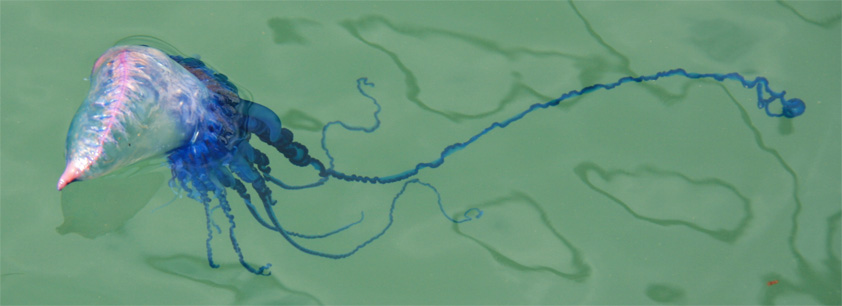Portuguese Man O War (Physalia Physalis)

Latin name: Physalia physalis
Common name: Portuguese man o' war
Other names: Blue bottle, blue bobble
Class: Hydrozoa
Order: Siphonophora
Family: Physaliidea
Genus: Physalia
Distribution: Atlantic.
Habitat: Floating on the surface of the sea with the tentacles reaching metres down into the water.
Behaviour: This animal usually moves in groups. It consists of four different colonies of polyps which cannot survive separately. Each highly specialised colony has different functions such as defence, reproduction or feeding. The bladder of the animal – a single polyp – floats on top of the sea and functions as a sail. It bumps from side to side to ensure that it stays wet, as this is essential for survival. The bladder is filled with carbon dioxide or nitrate and thus stays above water. In case of attack it can briefly deflate and go down. The tentacles below the sail cast for fish and other prey. Each tentacle carries poisonous cells (nematocysts) which paralyse or kill the prey.
Diet: Small fish, crustaceans.
Size: The float is some 30 cm long, each tentacle has some 10 to 12 metres length or is even longer.
Colour: Translucent bluish or greenish swim bladder, bluish tentacles.
Did you know? Skin contact with a Portuguese man o' war is dangerous. The animal releases a dangerous venom, which goes right under the human skin. Even days after its death the animal or detached tentacles can be hazardous. If you are affected, immediately go to the hospital. Don't treat the sting with fresh water, as it might worsen the effect on your system. Cool and wash the wound with salt water. A sting can cause skin irritation, pains, respiratory problems, allergic shocks, muscle spasms or even result in death. A sting is especially grave for humans with a heart condition.
The common name Portuguese man o' war goes back to the 15th century. Back then a type of Portuguese war ship carried this name. The shape of that ship had similarities to the swim bladder of the animal.